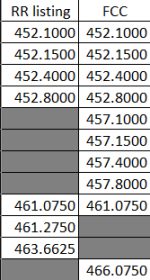I found a trunked system in my county that has essentially zero information about it in the database. I figured I could contribute to it and learn at the same time. This has led me down a rabbit hole but I think I will learn from it. For context I will be using WPMQ666 as the trunked system in question.
When looking at the sites frequencies HERE #1, there are only 7 frequencies listed compared to HERE #2 which list 10. The 10 listed are also identical to the FCC listing.
When looking at the sites frequencies HERE #1, there are only 7 frequencies listed compared to HERE #2 which list 10. The 10 listed are also identical to the FCC listing.
- Why is there a difference? Should they be the same? Why does each list (see attachment) contain frequencies that the other does not?
- Assuming the 7 frequencies from the RR listing is correct, how does one determine correct frequencies outside of the licensed frequencies for that site?
- If I were starting from scratch without the help of the RR database, would I put all 10 frequencies associated with this specific license as one "site?" What other information from the FCC license search would be useful?
- Will a control frequency always be transmitting? Or can there be intermittent pauses? It would appear that 452.150 is the control frequency as it never ceases that digital rumbling sound.
- I can't seem to grasp the concept of LCNs - when you need them all vs when you don't. How do I determine if I do or not when starting from scratch?
- Initially when I had the site programmed with the 7 original frequencies, the LCN search feature on my SDS200 found them all within minutes. I tried the same thing with the list of 10 frequencies and it took significantly longer aka did not finish after 24 hours. Will the LCNs found on the list of 7, be usable/equivalent on the list of 10 if the frequencies are on both lists? Or do LCNs change based on the full list of frequencies for a site?


